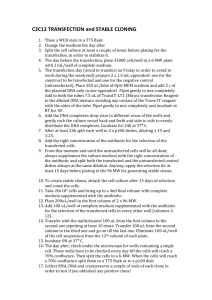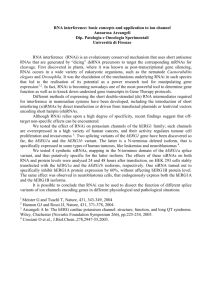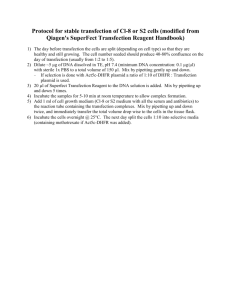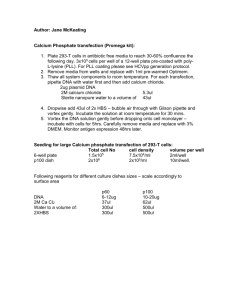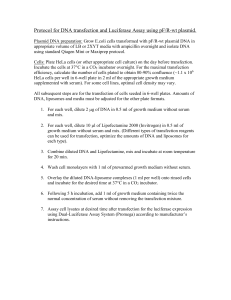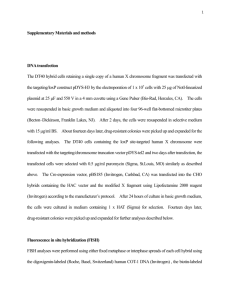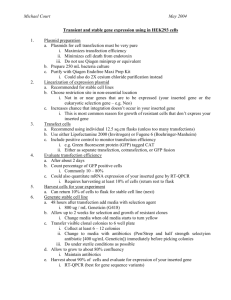Cell culture Cell culture
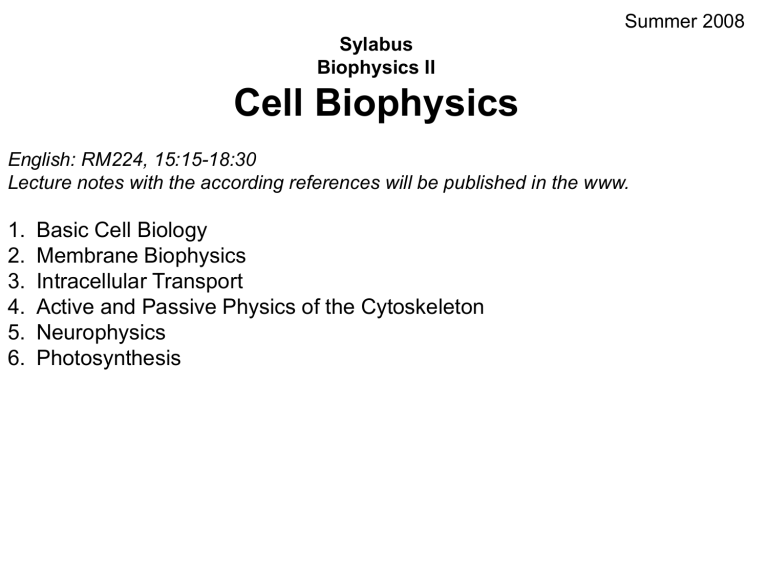
Sylabus
Biophysics II
Cell Biophysics
English: RM224, 15:15-18:30
Lecture notes with the according references will be published in the www.
1. Basic Cell Biology
2. Membrane Biophysics
3. Intracellular Transport
4. Active and Passive Physics of the Cytoskeleton
5. Neurophysics
6. Photosynthesis
Summer 2008
Biological Cell Introduction - Cell Biology
Textbooks
•Alberts B, Johnson A, Lewis J, Raff M, Roberts K, Walter P (2002). Molecular
Biology of the Cell , 4th ed., Garland. ISBN 0815332181 .
•Lodish H, Berk A, Matsudaira P, Kaiser CA, Krieger M, Scott MP, Zipurksy SL,
Darnell J (2004). Molecular Cell Biology , 5th ed., WH Freeman: New York, NY.
ISBN 978-0716743668 .
Comment to Homework 2
•Estimate the maximal size of a cell due to diffusion!
where d is the dimensionality, for a three dimensional system d=3
Einstein relation
Protein size: 5 nm cell viscosity: 1 Pa s
T = 300K
Diffusionszeit < 1 min => cell size < 30 µm
Cell culture
Cell culture is the process by which prokaryotic , eukaryotic or plant cells are grown under controlled conditions. In practice the term "cell culture" has come to refer to the culturing of cells derived from multicellular eukaryotes, especially animal cells.
The historical development and methods of cell culture are closely interrelated to those of tissue culture and organ culture .
http://www.lgcpromochem-atcc.com/ http://www.protocol-online.org/prot/Cell_Biology/Cell_Culture/ http://www.sigmaaldrich.com/Area_of_Interest/Life_Science/Cell_Culture/Key_Re sources/ECACC_Handbook.html
History
Animal cell culture became a routine laboratory technique in the 1950s,but the concept of maintaining live cell lines separated from their original tissue source was discovered in the 19th century.
The 19th-century English physiologist Sydney Ringer developed salt solutions containing the chlorides of sodium, potassium, calcium and magnesium suitable for maintaining the beating of an isolated animal heart outside of the body.
[1] In 1885
Wilhelm Roux removed a portion of the medullary plate of an embryonic chicken and maintained it in a warm saline solution for several days, establishing the principle of tissue culture.
[3] Ross Granville Harrison , working at Johns Hopkins
Medical School and then at Yale University , published results of his experiments from 1907-1910, establishing the methodology of tissue culture .
[4]
Cell culture techniques were advanced significantly in the 1940s and 1950s to support research in virology . Growing viruses in cell cultures allowed preparation of purified viruses for the manufacture of vaccines . The Salk polio vaccine was one of the first products mass-produced using cell culture techniques. This vaccine was made possible by the cell culture research of John Franklin Enders , Thomas Huckle
Weller , and Frederick Chapman Robbins , who were awarded a Nobel Prize for their discovery of a method of growing the virus in monkey kidney cell cultures.
Concepts in mammalian cell culture
Isolation of cells
Cells can be isolated from tissues for ex vivo culture in several ways. Cells can be easily purified from blood, however only the white cells are capable of growth in culture. Mononuclear cells can be released from soft tissues by enzymatic digestion with enzymes such as collagenase , trypsin , or pronase , which break down the extracellular matrix . Alternatively, pieces of tissue can be placed in growth media , and the cells that grow out are available for culture. This method is known as explant culture .
Cells that are cultured directly from a subject are known as primary cells . With the exception of some derived from tumours, most primary cell cultures have limited lifespan. After a certain number of population doublings cells undergo the process of senescence and stop dividing, while generally retaining viability.
An established or immortalised cell line has acquired the ability to proliferate indefinitely either through random mutation or deliberate modification, such as artificial expression of the telomerase gene . There are numerous well established cell lines representative of particular cell types.
List of cell lines cellline
HEK-293
HeLa
CHO
Sf-9
NIH-3T3
MTD-1A bEnd.3
MCF-10A
T84
HUVEC
HMEC
Peer
MDCK II
CMT
MyEnd
COS-7
HL-60
A-549
Jurkat meaning Organism human embryonic kidney human
Henrietta Lacks
Chinese hamster ovary human hamster
Spodoptera frugiperda insect Spodoptera frugiperda (moth)
NIH , 3-day transfer, inoculum 3 x 10 5 cells mouse mouse mouse brain endothelial
Michigan Cancer
Foundation human human human umbilical vein endothelial cells human mammary epithelial cell human human human
Madin Darby canine kidney canine mammary tumor myocardial endothelial
Cercopithecus aethiops, origin-defective SV-40 human leukemia dog dog mouse ape Cercopithecus aethiops ( Chlorocebus ) human human human
LNCap human origin tissue kidney (embryonic)
Cervical cancer
Ovary
Ovary embryo brain / cerebral Cortex mammary gland colorectal Carcinoma / lungmetastasis
Umbilical cord vein
T cell leukemia kidney mammary gland kidney
Myeloblast lungcarcinoma
T-CellLeukemia prostatic adenocarcinoma morphology epithelium epithelium epithelium epithelium epithelium endothelium fibroblast bloodcells epithelium bloodcells epithelium fibroblast epithelium endothelium epithelium epithelium endothelium epithelium
ATCC
DSMZ
DSMZ
DSMZ
ATCC
ATCC
ATCC
ATCC
ICLC link
ATCC
DSMZ
ICLC
DSMZ
ATCC
DSMZ
ATCC
Maintaining cells in culture
Cells are grown and maintained at an appropriate temperature and gas mixture
(typically, 37 °C , 5% CO2 ) in a cell incubator . Culture conditions vary widely for each cell type, and variation of conditions for a particular cell type can result in different phenotypes being expressed.
Aside from temperature and gas mixture, the most commonly varied factor in culture systems is the growth medium. Recipes for growth media can vary in pH , glucose concentration, growth factors , and the presence of other nutrient components. The growth factors used to supplement media are often derived from animal blood , such as calf serum . These blood-derived ingredients pose the potential for contamination of derived pharmaceutical products with viruses or prions . Current practice is to minimize or eliminate the use of these ingredients where possible.
Some cells naturally live without attaching to a surface, such as cells that exist in the bloodstream. Others require a surface, such as most cells derived from solid tissues. Cells grown unattached to a surface are referred to as suspension cultures .
Other adherent cultures cells can be grown on tissue culture plastic, which may be coated with extracellular matrix components to increase its adhesion properties and provide other signals needed for growth. Organotypic cultures involves growing cells in a 3-dimensional environment as opposed to 2-dimensional culture dishes. This
3D culture system is biochemically and physiologically more similar to in vivo tissue, but is technically challenging to maintain.
Media changes
The purpose of media changes is to replenish nutrients and avoid the build up of potentially harmful metabolic byproducts and dead cells. In the case of suspension cultures, cells can be separated from the media by centrifugation and resuspended in fresh media. In the case of adherent cultures, the media can be removed directly by aspiration and replaced.
Passaging cells
Passaging or splitting cells involves transferring a small number of cells into a new vessel. Cells can be cultured for a longer time if they are split regularly, as it avoids the senescence associated with prolonged high cell density. Suspension cultures are easily passaged with a small amount of culture containing a few cells diluted in a larger volume of fresh media. For adherent cultures, cells first need to be detached; this is commonly done with a mixture of trypsin EDTA , however other enzyme mixes are now available for this purpose. A small number of detached cells can then be used to seed a new culture.
Cell Thawing/Freezing Protocol
Freezing Cells:
•Cells should be growing well or known to be in log phase
•Count, collect and pellet cells in a 15mL test tube
•Resuspend in freezing media so that the concentration is no more than 5x10^6 cells/mL of cold freezing media (see below for freezing media recipe)
•Transfer 1mL of cells to appropriately labelled cryovials and maintain on ice for approximately 30minutes
•Transfer vials to -80C freezer for 24hrs
•Transfer to liquid nitrogen dewar or -140C freezer for long-term storage.
Freezing media
5% DMSO
95% FCS
1mL / 5x10^6 cells
Thawing Cells:
•Remove vial from Liquid Nitrogen or -140C freezer and immediately transfer to 37C water bath
•While holding the tip of the vial, gently agitate the vial, being careful not to allow water to penetrate the cap or seal
•When completely thawed, transfer contents of vial to 15mL test tube
•Slowly add 10mL warm complete media and spin at 1000g for 5min
•Decant media and resuspend pellet in a volume of complete media appropriate for flask or macrowell
•Transfer cells to flask or 24 well plate and incubate at 37C and 5%CO2
•Cells can be checked visually or counted, beginning at approximately 1hr, for an estimate of viability.
•Immediate cell counts can be misleading
Transfection
Transfection describes the introduction of foreign material into eukaryotic cells using a virus vector or other means of transfer. The term transfection for non-viral methods is most often used in reference to mammalian cells, while the term transformation is preferred to describe non-viral DNA transfer in bacteria and non-animal eukaryotic cells such as fungi , algae and plants .
Transfection of animal cells typically involves opening transient pores or 'holes' in the cell plasma membrane , to allow the uptake of material. Genetic material (such as supercoiled plasmid DNA or siRNA constructs), or even proteins such as antibodies , may be transfected. In addition to electroporation , transfection can be carried out by mixing a cationic lipid with the material to produce liposomes , which fuse with the cell plasma membrane and deposit their cargo inside.
Methods
There are various methods of introducing foreign DNA into a eukaryotic cell . Many materials have been used as carriers for transfection, which can be divided into three kinds: (cationic) polymers, liposomes and nanoparticles.
One of the cheapest (and least reliable) methods is transfection by calcium phosphate , originally discovered by F.
L. Graham and A. J. van der Eb in 1973 [1] (see also [2] ). HEPES -buffered saline solution (HeBS) containing phosphate ions is combined with a calcium chloride solution containing the DNA to be transfected. When the two are combined, a fine precipitate of the positively charged calcium and the negatively charged phosphate will form, binding the DNA to be transfected on its surface. The suspension of the precipitate is then added to the cells to be transfected (usually a cell culture grown in a monolayer). By a process not entirely understood, the cells take up some of the precipitate, and with it, the DNA.
Other methods use highly branched organic compounds, so-called dendrimers , to bind the DNA and get it into the cell. A very efficient method is the inclusion of the DNA to be transfected in liposomes , i.e. small, membranebounded bodies that are in some ways similar to the structure of a cell and can actually fuse with the cell membrane , releasing the DNA into the cell. For eukaryotic cells, lipid-cation based transfection is more typically used, because the cells are more sensitive.
Another method is the use of cationic polymers such as DEAE-dextran or polyethylenimine. The negatively charged DNA binds to the polycation and the complex is taken up by the cell via endocytosis .
A direct approach to transfection is the gene gun , where the DNA is coupled to a nanoparticle of an inert solid
(commonly gold) which is then "shot" directly into the target cell's nucleus . DNA can also be introduced into cells using viruses as a carrier. In such cases, the technique is called viral transduction , and, the cells are said to be transduced.
Other methods of transfection include nucleofection , electroporation , heat shock , magnetofection and proprietary transfection reagents such as Lipofectamine , Dojindo Hilymax, Fugene, jetPEI, Effectene or DreamFect.
The Physics of Transfection
•"An Inverted Hexagonal Phase of DNA-Cationic Liposome Complexes Related to
DNA Release", I. Koltover, T. Salditt, J. Raedler, C. R. Safinya, Science 281 , 78-81
(1998).
•"Structure of DNA-Cationic Liposome Complexes: DNA Intercalation in Multi-
Lamellar Membranes in Distinct Interhelical Packing Regimes", J. O. Raedler, I.
Koltover, T. Salditt, C. R. Safinya Science 275 , 810 (1997).
•"Two Dimensional Smectic Ordering of Linear DNA Chains in Self-Assembled DNA-
Cationic Liposome Mixtures", T. Salditt, I. Koltover, J.O. Raedler, C. R. Safinya,
Physical Review Letters 79 , 2582 (1997).
Stable and transient transfection
For most applications of transfection, it is sufficient if the transfected gene is only transiently expressed. Since the DNA introduced in the transfection process is usually not inserted into the nuclear genome, the foreign DNA is lost at the later stage when the cells undergo mitosis .
If it is desired that the transfected gene actually remains in the genome of the cell and its daughter cells, a stable transfection must occur.
To accomplish this, another gene is co-transfected, which gives the cell some selection advantage, such as resistance towards a certain toxin . Some (very few) of the transfected cells will, by chance, have inserted the foreign genetic material into their genome. If the toxin, towards which the co-transfected gene offers resistance, is then added to the cell culture, only those few cells with the foreign genes inserted into their genome will be able to proliferate , while other cells will die. After applying this selection pressure for some time, only the cells with a stable transfection remain and can be cultivated further.
A common agent for stable transfection is Geneticin , also known as G418, which is a toxin that can be neutralized by the product of the neomycin resistant gene .
RNA interference
RNA interference ( RNAi ) is a mechanism that inhibits gene expression at the stage of translation or by hindering the transcription of specific genes. RNAi targets include RNA from viruses and transposons
(significant for some forms of innate immune response ), and also plays a role in regulating development and genome maintenance. Small interfering RNA strands (siRNA) are key to the RNAi process, and have complementary nucleotide sequences to the targeted RNA strand. Specific RNAi pathway proteins are guided by the siRNA to the targeted messenger RNA (mRNA), where they "cleave" the target, breaking it down into smaller portions that can no longer be translated into protein. A type of RNA transcribed from the genome itself, microRNA (miRNA), works in the same way.
[2]
The RNAi pathway is initiated by the enzyme dicer , which cleaves long, dsRNA molecules into short fragments of 20 –25 base pairs . One of the two strands of each fragment, known as the guide strand , is then incorporated into the RNA-induced silencing complex (RISC) and pairs with complementary sequences. The most wellstudied outcome of this recognition event is post-transcriptional gene silencing . This occurs when the guide strand specifically pairs with an mRNA molecule and induces the degradation by argonaute , the catalytic component of the RISC complex. Another outcome is epigenetic changes to a gene – histone modification and
DNA methylation – affecting the degree the gene is transcribed.
The selective and robust effect of RNAi on gene expression makes it a valuable research tool, both in cell culture and in living organisms because synthetic dsRNA introduced into cells can induce suppression of specific genes of interest. RNAi may also be used for large-scale screens that systematically shut down each gene in the cell, which can help identify the components necessary for a particular cellular process or an event such as cell division . Exploitation of the pathway is also a promising tool in biotechnology and medicine .
Historically, RNA interference was known by other names, including post transcriptional gene silencing , transgene silencing, and quelling. Only after these apparently-unrelated processes were fully understood did it become clear that they all described the RNAi phenomenon. RNAi has also been confused with antisense suppression of gene expression, which does not act catalytically to degrade mRNA, but instead involves singlestranded RNA fragments physically binding to mRNA and blocking protein translation . In 2006, Andrew Fire and
Craig C. Mello shared the Nobel Prize in Physiology or Medicine for their work on RNA interference in the nematode worm C. elegans , [3] which they published in 1998.
[4]
Homework 3
• Define what is a phase for the state of matter in physics?
• How does a liquid crystal display work? Who was the inventor?
• How does a molecule become hydrophobic or hydrophilic?
